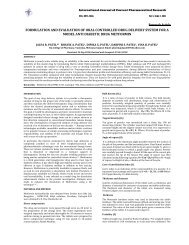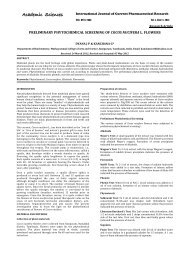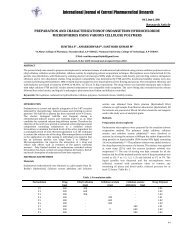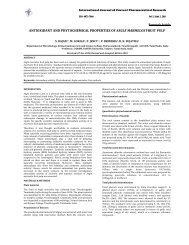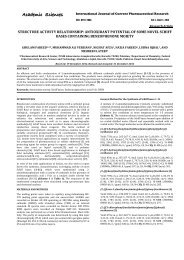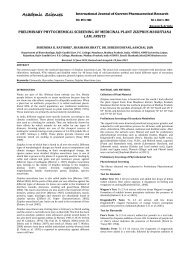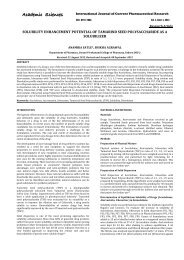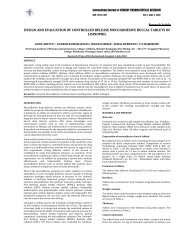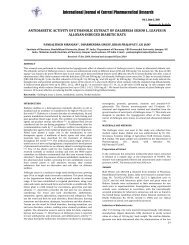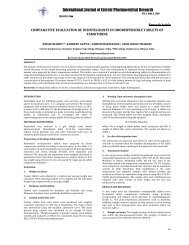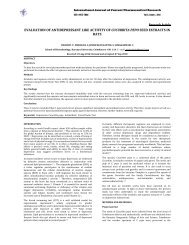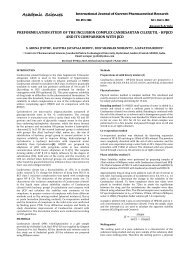formulation and in vitro evaluation of mucoadhesive tablets of ...
formulation and in vitro evaluation of mucoadhesive tablets of ...
formulation and in vitro evaluation of mucoadhesive tablets of ...
You also want an ePaper? Increase the reach of your titles
YUMPU automatically turns print PDFs into web optimized ePapers that Google loves.
International Journal <strong>of</strong> Current Pharmaceutical ResearchISSN- 0975-7066 Vol 3, Issue 2, 2011Research ArticleFORMULATION AND IN VITRO EVALUATION OF MUCOADHESIVE TABLETS OF OFLOXACINUSING NATURAL GUMSPRAMOD PATIL, SURESH V KULKARNI * , SOMESHWARA RAO B, ANAND AMMANAGE, CHETAN SURPUR,BASAVARAJDepartment <strong>of</strong> Pharmaceutics, Sree Siddaganga College <strong>of</strong> Pharmacy, B.H.Road, Tumkur572102, Karnataka, IndiaEmail: drsvk.sscp@gmail.comReceived: 28 Nov 2010, Revised <strong>and</strong> Accepted: 31 Dec 2010ABSTRACTThe present study concerns the development <strong>of</strong> <strong>mucoadhesive</strong> <strong>tablets</strong> <strong>of</strong> <strong>of</strong>loxac<strong>in</strong> which were designed to prolong the gastric residence time afteroral adm<strong>in</strong>istration. Ofloxac<strong>in</strong> is a fluoroqu<strong>in</strong>olone antibacterial agent which is highly effective aga<strong>in</strong>st gram positive <strong>and</strong> gram negative bacteria.Different types <strong>of</strong> natural gums such as guar gum, locust bean gum <strong>and</strong> their comb<strong>in</strong>ations were used to formulate the <strong>mucoadhesive</strong> <strong>of</strong>loxac<strong>in</strong><strong>tablets</strong>. Tablets were prepared us<strong>in</strong>g wet granulation method <strong>and</strong> were evaluated for parameters such as Weight variation, Hardness, Friability,Drug content, Swell<strong>in</strong>g <strong>in</strong>dex, <strong>in</strong> <strong>vitro</strong> drug release study, <strong>in</strong> <strong>vitro</strong> <strong>mucoadhesive</strong> strength study. All the <strong>formulation</strong> showed compliance withpharmacopieal st<strong>and</strong>ards. Among all the <strong>formulation</strong>s, F7 with the comb<strong>in</strong>ation <strong>of</strong> guar gum <strong>and</strong> locust bean gum showed greater <strong>in</strong> <strong>vitro</strong> drugrelease (98.23% at the end <strong>of</strong> 12 hrs), good swell<strong>in</strong>g <strong>and</strong> better <strong>mucoadhesive</strong> strength than us<strong>in</strong>g a s<strong>in</strong>gle gum <strong>and</strong> other gum comb<strong>in</strong>ations. So, the<strong>formulation</strong> (F7) was selected as optimized. The drug release <strong>of</strong> optimized <strong>formulation</strong> follows the Higuchi k<strong>in</strong>etic model, <strong>and</strong> the mechanism isfound to be non‐Fickian/anomalous accord<strong>in</strong>g to Korsmeyer–Peppas (n value is 0.615). Stability studies were carried out accord<strong>in</strong>g to ICH guidel<strong>in</strong>ewhich <strong>in</strong>dicates that <strong>formulation</strong> F7 was stable.Keywords: Mucoadhesive <strong>tablets</strong>, Ofloxac<strong>in</strong>, Guar gum, Locust bean gumINTRODUCTIONThe primary aim <strong>of</strong> oral controlled drug delivery system is to deliverdrugs for longer period <strong>of</strong> time to achieve better bioavailability,which should be predictable <strong>and</strong> reproducible. But this is difficultdue to number <strong>of</strong> physiological problems such as fluctuation <strong>in</strong> thegastric empty<strong>in</strong>g process, narrow absorption w<strong>in</strong>dow <strong>and</strong> stabilityproblem <strong>in</strong> the <strong>in</strong>test<strong>in</strong>e. 1 To overcome these problems, differentapproaches have been proposed to reta<strong>in</strong> dosage form <strong>in</strong> stomach.These <strong>in</strong>clude bioadhesive or <strong>mucoadhesive</strong> systems, 2 swell<strong>in</strong>g <strong>and</strong>exp<strong>and</strong><strong>in</strong>g systems, 3,4 float<strong>in</strong>g systems 5,6 <strong>and</strong> other delayed gastricempty<strong>in</strong>g devices.Bioadhesion may be def<strong>in</strong><strong>in</strong>g as the state <strong>in</strong> which two materials, atleast one <strong>of</strong> which is biological <strong>in</strong> nature, are held together forextended period by <strong>in</strong>terfacial forces. In the pharmaceuticalsciences, when the adhesive attachment is to mucous membrane thephenomenon is referred to as mucoadhesion. 7 Bioadhesive<strong>formulation</strong>s use polymers as the adhesive component. Thesepolymers are <strong>of</strong>ten water soluble <strong>and</strong> when used <strong>in</strong> a dry form, theyattract water from the mucosal surface <strong>and</strong> this water transfer leadsto strong <strong>in</strong>teraction. These polymers also form viscous layers whenhydrated with water, which <strong>in</strong>creases the retention time over themucosal surfaces leads to adhesive <strong>in</strong>teractions. 8The pr<strong>in</strong>ciple <strong>of</strong> <strong>mucoadhesive</strong> preparation <strong>of</strong>fers a simple practicalapproach <strong>and</strong> is particularly useful to prolong the retention time <strong>of</strong> adosage form <strong>in</strong> the stomach, thereby improv<strong>in</strong>g the oralbioavailability <strong>of</strong> the drug. 9Ofloxac<strong>in</strong> is a fluoroqu<strong>in</strong>olone antibacterial agent which is highlyeffective aga<strong>in</strong>st gram positive <strong>and</strong> gram negative bacteria. 10Ofloxac<strong>in</strong> exhibits pH dependent solubility. The solubility <strong>of</strong><strong>of</strong>loxac<strong>in</strong> <strong>in</strong> water is 60 mg/ml at pH value rang<strong>in</strong>g from 2 to 5, fallsto 4 mg/ml at pH 7 (near isoelectric pH). 11 Thus it is more soluble <strong>in</strong>acidic pH <strong>and</strong> slightly soluble at neutral or alkal<strong>in</strong>e condition(<strong>in</strong>test<strong>in</strong>al environment). Hence an attempt was made to developgastroretentive delivery system <strong>of</strong> <strong>of</strong>loxac<strong>in</strong> by us<strong>in</strong>g natural gumsuch as guar gum, locust bean gum which would <strong>in</strong>crease thebioavailability <strong>of</strong> <strong>of</strong>loxac<strong>in</strong> <strong>and</strong> also to reduce frequency <strong>of</strong>adm<strong>in</strong>istration, thereby improv<strong>in</strong>g patient compliance <strong>and</strong>therapeutic efficacy.MATERIALS AND METHODSMaterialsOfloxac<strong>in</strong> was obta<strong>in</strong>ed as gift sample from Blue Cross LaboratoriesLtd, Mumbai. Guar gum was obta<strong>in</strong>ed from Himedia Mumbai, Locustbean gum was obta<strong>in</strong>ed from Research Lab F<strong>in</strong>e Chemical IndustriesMumbai. All other <strong>in</strong>gredients used were <strong>of</strong> analytical grade.Preparation <strong>of</strong> <strong>mucoadhesive</strong> <strong>tablets</strong>Mucoadhesive <strong>tablets</strong> were prepared by conventional wetgranulation. The powder mix was granulated with 5% w/w PVP‐K30<strong>in</strong> isopropyl alcohol. The wet mass was passed through sieve # 16<strong>and</strong> the granules were dried at 60°C for 1 hrs <strong>in</strong> a hot air oven. Thedried granules were passed through sieve # 22 <strong>and</strong> lubricated withmagnesium stearate <strong>and</strong> talc by further blend<strong>in</strong>g for 3 m<strong>in</strong>. Tabletswere compressed at 500 mg weight on a 10 station m<strong>in</strong>i rotarytablet<strong>in</strong>g mach<strong>in</strong>e with 12 mm flat‐shaped punches. Tablets <strong>of</strong> BatchF1‐F3 <strong>and</strong> F4‐F6 conta<strong>in</strong> only s<strong>in</strong>gle <strong>mucoadhesive</strong> polymer hav<strong>in</strong>gconcentration 25%, 30%, <strong>and</strong> 35% respectively. Whereas Batch F7‐F9 conta<strong>in</strong> comb<strong>in</strong>ation <strong>of</strong> <strong>mucoadhesive</strong> polymers with totalpolymer concentration <strong>of</strong> 30%.Evaluation <strong>of</strong> granulesThe angle <strong>of</strong> repose was measured by us<strong>in</strong>g funnel method, 12 which<strong>in</strong>dicates the flow ability <strong>of</strong> the granules. Loose bulk density (LBD)<strong>and</strong> tapped bulk density (TBD) 13 were measured us<strong>in</strong>g the formula:LBD= weight <strong>of</strong> the powder / volume <strong>of</strong> the pack<strong>in</strong>g. TBD= weight <strong>of</strong>the powder / tapped volume <strong>of</strong> the pack<strong>in</strong>g. Compressibility <strong>in</strong>dex 14<strong>of</strong> the granules was determ<strong>in</strong>ed by us<strong>in</strong>g the formula:CI (%) = [(TBD‐LBD/TBD)] ×100.Evaluation <strong>of</strong> <strong>tablets</strong>All prepared <strong>mucoadhesive</strong> <strong>tablets</strong> were evaluated for its uniformity<strong>of</strong> weight, hardness, friability <strong>and</strong> thickness accord<strong>in</strong>g to <strong>of</strong>ficialmethods. 15 The weight variation was determ<strong>in</strong>ed by tak<strong>in</strong>g 20<strong>tablets</strong> us<strong>in</strong>g an electronic balance (type ER182A, Afcoset, Mumbai,India). Tablet hardness was determ<strong>in</strong>ed us<strong>in</strong>g a Monsanto tablethardness tester (MHT‐20, Campbell Electronics, Mumbai, India).Friability was determ<strong>in</strong>ed by test<strong>in</strong>g 10 <strong>tablets</strong> <strong>in</strong> a friability tester(FTA‐20, Campbell Electronics) for 4 m<strong>in</strong>utes at 25 rpm.
Kulkarni et al.Int J Curr Pharm Res, Vol 3, Issue 2, 9398Table 1: Composition <strong>of</strong> different <strong>formulation</strong>sIngredients(mg /tablet)FormulationF1 F2 F3 F4 F5 F6 F7 F8 F9Ofloxac<strong>in</strong> 200 200 200 200 200 200 200 200 200Guar gum 125 150 175 ‐ ‐ ‐ 113 75 37Locust bean gum ‐ ‐ ‐ 125 150 175 37 75 113Magnesium10 10 10 10 10 10 10 10 10stearateTalc 5 5 5 5 5 5 5 5 5MCC 98 73 48 98 73 48 73 73 73PVP K30 12 12 12 12 12 12 12 12 12Total weight <strong>of</strong> tablet‐500mgDrug contentFive <strong>tablets</strong> were powdered <strong>in</strong> a mortar. An accurately weighedquantity <strong>of</strong> powdered <strong>tablets</strong> (100 mg) was extracted with 0.1N HCl(pH 1.2 buffer) <strong>and</strong> the solution was filtered through 0.45 µmembranes. Each extract was suitably diluted <strong>and</strong> analyzedspectrophotometrically at 294 nm.Swell<strong>in</strong>g study <strong>of</strong> <strong>formulation</strong>s 16Swell<strong>in</strong>g study <strong>of</strong> <strong>in</strong>dividual batch was carried out us<strong>in</strong>g USPdissolution apparatus‐II (rotat<strong>in</strong>g paddle), <strong>in</strong> 900 ml <strong>of</strong> 0.1N HClwhich is ma<strong>in</strong>ta<strong>in</strong>ed at 37±0.5°C, rotated at 100 rpm. Weight <strong>of</strong><strong>in</strong>dividual tablet was taken prior to the swell<strong>in</strong>g study (W1). Thetablet was kept <strong>in</strong> a basket. The tablet was removed every one hour<strong>in</strong>terval up to 12 hour <strong>and</strong> excess water removed carefully us<strong>in</strong>gfilter paper. The swollen <strong>tablets</strong> were re‐weighed (W2); Percenthydration (swell<strong>in</strong>g <strong>in</strong>dex) was calculated as shown <strong>in</strong> table 4 us<strong>in</strong>gfollow<strong>in</strong>g formula,% Swell<strong>in</strong>g Index = {(W2) – (W1)/ (W1)} x 100Where W1‐ <strong>in</strong>itial weight <strong>of</strong> tablet, W2‐ weight <strong>of</strong> the swollen tablet.In <strong>vitro</strong> mucoadhesion studies17, 18, 19The <strong>mucoadhesive</strong> strength <strong>of</strong> the <strong>tablets</strong> was measured on modifiedphysical balance. The apparatus consist <strong>of</strong> a modified double beamphysical balance <strong>in</strong> which the right <strong>and</strong> left pan were with lighterpans. The left side <strong>of</strong> the balance was made heavier than the rightside by plac<strong>in</strong>g a 5 g weight on left side pan. Another Teflon block <strong>of</strong>3.8 cm diameter <strong>and</strong> 2 cm height was fabricated with an upwardprotrusion <strong>of</strong> 2 cm height <strong>and</strong> 1.5 cm diameter on one side. This waskept <strong>in</strong> the beaker, which was then placed below the left h<strong>and</strong> set <strong>of</strong>the balance. The goat gastric mucus membrane was used as themodel membrane <strong>and</strong> pH 1.2 buffer solution was used as themoisten<strong>in</strong>g fluid. The goat stomach mucosa was kept <strong>in</strong> tyrodesolution at 37 o C for 2 hr. The underly<strong>in</strong>g mucus membrane wasseparated <strong>and</strong> washed thoroughly with a pH 1.2 buffersolution. It was then tied to a Teflon‐coated glass slide <strong>and</strong> this slidewas fixed over the protrusion <strong>in</strong> the Teflon block us<strong>in</strong>g a thread. Theblock was then kept <strong>in</strong> a beaker conta<strong>in</strong><strong>in</strong>g pH 1.2 buffer solution ata level that just touches the membrane so as to moisten themembrane. By keep<strong>in</strong>g a 5 g weight on the right pan that two sideswere balanced. The beaker with the Teflon block was kept below theleft h<strong>and</strong> setup <strong>of</strong> the balance. The tablet was stuck on to the lowerside <strong>of</strong> the left h<strong>and</strong> side pan. The 5 g weight from the right pan wasthen removed. This lowered the left pan along with the tablet overthe membrane with the weight <strong>of</strong> 5 g. This was kept undisturbed for3 m<strong>in</strong>. Then the weight on the right h<strong>and</strong> side was added <strong>in</strong> an<strong>in</strong>crement <strong>of</strong> 0.5 g until the tablet just separates from the membranesurface. The excess weight on the right pan i.e.total weight m<strong>in</strong>us 5 g was taken as the measure <strong>of</strong> the<strong>mucoadhesive</strong> strength from the <strong>mucoadhesive</strong> strength, the force <strong>of</strong>adhesion was calculated us<strong>in</strong>g follow<strong>in</strong>g formula;Force <strong>of</strong> adhesion (N) = Mucoadhesive strength/100 × 9.81.In <strong>vitro</strong> drug release studyIn<strong>vitro</strong> drug release studies were carried out us<strong>in</strong>g USP XXIIdissolution apparatus type II (Electrolab, Mumbai, India) at 100 rpm.The dissolution medium consisted <strong>of</strong> 900 ml <strong>of</strong> 0.1N HCl (pH 1.2),ma<strong>in</strong>ta<strong>in</strong>ed at 37 + 0.5 0 C. The dissolution samples were collected atevery 1 hour <strong>in</strong>terval <strong>and</strong> replaced with an equal volume <strong>of</strong> 0.1N HClto ma<strong>in</strong>ta<strong>in</strong> the volume constant. The sample solution was dilutedsufficiently <strong>and</strong> analyzed at 294nm us<strong>in</strong>g an UV spectrophotometer(Lab<strong>in</strong>dia, Mumbai, India). The study was performed <strong>in</strong> triplicate.Drug release k<strong>in</strong>etics (Curve fitt<strong>in</strong>g analysis)To analyze the mechanism <strong>of</strong> the drug release rate k<strong>in</strong>etics <strong>of</strong> thedosage form, the data obta<strong>in</strong>ed were fitted <strong>in</strong>to zero order, firstorder Higuchi model <strong>and</strong> Korsmeyer’s equation release models. 18, 19Stability studiesTo assess the drug <strong>and</strong> <strong>formulation</strong> stability, stability studies weredone accord<strong>in</strong>g to ICH guidel<strong>in</strong>es. 20 The optimized <strong>formulation</strong> wassubjected to stability study at 40 ± 2ºC <strong>and</strong> 75 ± 5% RH for 90 days.The samples were evaluated for physical changes, hardness,friability, drug content, <strong>mucoadhesive</strong> properties <strong>and</strong> percentagedrug release dur<strong>in</strong>g the stability studies.RESULTS AND DISCUSSIONFTIR spectroscopyThe pure drug <strong>of</strong>loxac<strong>in</strong> <strong>and</strong> the solid admixture <strong>of</strong> drug <strong>and</strong> variouspolymers used <strong>in</strong> the preparation <strong>of</strong> <strong>mucoadhesive</strong> tablet<strong>formulation</strong>s were characterized by FT‐IR spectroscopy to know thecompatibility. As shown <strong>in</strong> figure 1‐2, there was no significantdifference or the characteristic peak <strong>of</strong> pure drug was unchanged <strong>in</strong>spectrum <strong>of</strong> optimized <strong>formulation</strong>.Characterization <strong>of</strong> powder blendGranules prepared for compression <strong>of</strong> <strong>mucoadhesive</strong> <strong>tablets</strong> wereevaluated for their flow properties, the results were shown <strong>in</strong> Tables2. Angle <strong>of</strong> repose was <strong>in</strong> the range <strong>of</strong> 25.30± 1.34 to 29.74 ± 0.73which <strong>in</strong>dicates excellent flow <strong>of</strong> the powder for all <strong>formulation</strong>s.The bulk density <strong>of</strong> the powder <strong>formulation</strong> was <strong>in</strong> the range <strong>of</strong>0.3806 ± 0.012 to 0.4188 ±0.027gm/ml; the tapped density was <strong>in</strong>the range <strong>of</strong> 0.4517 ± 0.017 to 0.4854 ± 0.018 gm/ml, which<strong>in</strong>dicates that the powder was not bulky. The Compressibility <strong>in</strong>dexwas found to be <strong>in</strong> the range <strong>of</strong> 9.83 ± 1.76 to 15.74 ± 0.48,<strong>in</strong>dicat<strong>in</strong>g compressibility <strong>of</strong> the tablet blend is good. These values<strong>in</strong>dicate that the prepared granules exhibited good flow properties.Physicochemical <strong>evaluation</strong> <strong>of</strong> <strong>mucoadhesive</strong> <strong>tablets</strong>The <strong>of</strong>loxac<strong>in</strong> <strong>mucoadhesive</strong> <strong>tablets</strong> were <strong>of</strong>f‐white, smooth, <strong>and</strong> flatshaped <strong>in</strong> appearance. The results <strong>of</strong> physicochemicalcharacterizations are shown <strong>in</strong> Tables 3. The thickness <strong>of</strong><strong>mucoadhesive</strong> <strong>tablets</strong> were measured by vernier caliper <strong>and</strong> wereranged between 3.72±0.06 to 3.74±0.06 mm. Weight variation fordifferent <strong>formulation</strong>s were found to be 498.5±1.677 to 551.2±1.337mg, show<strong>in</strong>g satisfactory results as per Indian Pharmacopoeia (IP)limit. The hardness <strong>of</strong> the <strong>mucoadhesive</strong> <strong>tablets</strong> was measured byMonsanto tester <strong>and</strong> was controlled between 6.2±0.312 to 6.7±0.167kg/cm 2 . The friability was below 1% for all the <strong>formulation</strong>s, whichis an <strong>in</strong>dication <strong>of</strong> good mechanical resistance <strong>of</strong> the tablet. Thepercentage <strong>of</strong> drug content for F1 to F9 was found to be <strong>in</strong> between97.81% to 100.37% <strong>of</strong> <strong>of</strong>loxac<strong>in</strong> it complies with <strong>of</strong>ficialspecifications.94
Kulkarni et al.Int J Curr Pharm Res, Vol 3, Issue 2, 9398Fig. 1: FTIR Spectroscopy <strong>of</strong> pure drugFig. 2: FTIR Spectroscopy <strong>of</strong> <strong>formulation</strong> F7Table 2: Granules properties <strong>of</strong> <strong>formulation</strong>s F1 to F9 <strong>of</strong> Ofloxac<strong>in</strong> <strong>mucoadhesive</strong> <strong>tablets</strong>FormulationNo.Angle <strong>of</strong> repose*Loose bulk density (LBD)(g/ml) *Tapped bulk density(TBD) (g/ml) *Compressibility <strong>in</strong>dex(%)*F1 27.31 ± 1.08 0.4132 ± 0.021 0.4854 ± 0.018 14.88 ± 1.41F2 25.30 ± 1.34 0.4098 ±0.017 0.4545 ± 0.019 9.83 ± 1.76F3 26.56 ± 1.81 0.4032 ± 0.003 0.4629 ± 0.011 12.89 ± 1.58F4 25.40 ± 1.53 0.3806 ± 0.012 0.4517 ± 0.017 15.74 ± 0.48F5 28.54 ± 1.81 0.4111 ± 0.014 0.4728 ± 0.013 13.04 ± 1.78F6 26.40 ± 1.44 0.4188 ±0.027 0.4746 ± 0.016 11.75 ± 1.36F7 29.74 ± 0.73 0.3968 ± 0.017 0.4408 ± 0.013 11.97 ± 0.61F8 27.47 ± 1.03 0.4065 ± 0.013 0.4761 ± 0.013 14.63 ± 0.71F9 27.40 ± 1.53 0.3906 ± 0.025 0.4587 ± 0.016 14.87 ± 0.58* (n=3, ±S.D.)Table 3: Tablet properties <strong>of</strong> <strong>formulation</strong>s F1 to F9 <strong>of</strong> Ofloxac<strong>in</strong> <strong>mucoadhesive</strong> <strong>tablets</strong>FormulationNo.Hardness*(kg/cm 2 )Thickness* (mm) %FriabilityWeightVariation*(mg)%Drug contentF1 6.3±0.218 3.73±0.04 0.534 500.2±1.844 99.35F2 6.5±0.113 3.74±0.03 0.47 498.5±1.677 98.50F3 6.2±0.312 3.73±0.05 0.654 499.2±1.877 99.37F4 6.7±0.167 3.72±0.06 0.667 500.3±1.566 100.37F5 6.4±0.239 3.75±0.04 0.445 499.6±1.132 97.81F6 6.6±0.347 3.73±0.04 0.545 551.2±1.337 98.44F7 6.4±0.212 3.74±0.05 0.321 499.8±1.323 99.65F8 6.3±0.442 3.74±0.06 0.484 500.6±0.434 99.06F9 6.5±0.243 3.73±0.05 0.652 501.3±1.678 98.75* (n=3, ±S.D.)95
Kulkarni et al.Int J Curr Pharm Res, Vol 3, Issue 2, 9398Swell<strong>in</strong>g <strong>in</strong>dexSwell<strong>in</strong>g <strong>in</strong>dex was performed for all the batches (F1‐F9) up to 12hrs. The results were shown <strong>in</strong> Table 4. It was found that swell<strong>in</strong>g<strong>in</strong>dex are directly proportional to the concentration <strong>of</strong> the gum, asthe gum concentration <strong>in</strong>creases there is <strong>in</strong>crease <strong>in</strong> swell<strong>in</strong>g <strong>in</strong>dex.Thus, the viscosity <strong>of</strong> the gum had major <strong>in</strong>fluence on swell<strong>in</strong>gprocess, matrix <strong>in</strong>tegrity, as well as adhesion property. Graphicalrepresentation swell<strong>in</strong>g <strong>in</strong>dex <strong>of</strong> all the batches were shown <strong>in</strong>figure 3.Table 4: Swell<strong>in</strong>g Index <strong>of</strong> <strong>mucoadhesive</strong> <strong>tablets</strong>Time <strong>in</strong> Swell<strong>in</strong>g <strong>in</strong>dex (%) Formulation code‘hrs’ F1 F2 F3 F4 F5 F6 F7 F8 F90 0 0 0 0 0 0 0 0 01 14 16 29 17 23 41 21 24 192 32 38 54 39 48 67 44 43 403 51 61 73 63 69 91 63 67 654 73 81 90 87 91 112 89 91 925 94 104 117 121 112 147 111 116 1176 111 119 135 145 147 176 126 137 1517 133 135 149 173 176 198 145 161 1768 141 152 167 185 198 222 159 179 2069 153 177 194 190 222 245 181 198 22310 160 203 216 197 245 261 206 220 23611 168 217 228 201 261 273 222 237 25912 170 210 222 205 273 298 238 256 269Fig. 3: Swell<strong>in</strong>g Index <strong>of</strong> <strong>mucoadhesive</strong> <strong>tablets</strong> F1F9Table 5: In <strong>vitro</strong> <strong>mucoadhesive</strong> strength study <strong>of</strong> the prepared <strong>mucoadhesive</strong> <strong>tablets</strong>Formulation code Mucoadhesive strength* (g) Mucoadhesion force (N)F1 17.27±0.45 1.69F2 23.22±0.34 2.27F3 26.11±0.67 2.56F4 19.67±0.38 1.92F5 22.13±0.78 2.17F6 24.47±0.54 2.40F7 25.51±0.65 2.50F8 23.74±0.39 2.32F9 24.08±0.57 2.36* (n=3, ±S.D.)In <strong>vitro</strong> <strong>mucoadhesive</strong> studyThe <strong>in</strong> <strong>vitro</strong> <strong>mucoadhesive</strong> study was performed on modifiedphysical balance <strong>and</strong> measures the <strong>mucoadhesive</strong> strength (g)requires to detach the tablet. The <strong>mucoadhesive</strong> characteristicswere affected by the concentration <strong>of</strong> the gum. Increase <strong>in</strong>concentration <strong>of</strong> gum <strong>in</strong>creases <strong>mucoadhesive</strong> strength <strong>of</strong><strong>formulation</strong>. Batch F3 with 35% guar gum shows greater<strong>mucoadhesive</strong> strength. The results were shown <strong>in</strong> Table 5.In <strong>vitro</strong> release studyIn <strong>vitro</strong> dissolution studies <strong>of</strong> all the <strong>formulation</strong>s <strong>of</strong> <strong>mucoadhesive</strong><strong>tablets</strong> were carried out <strong>in</strong> 0.1N HCl (pH 1.2). The study wasperformed for 12 hrs. The variation <strong>in</strong> drug release was due todifferent concentrations <strong>of</strong> polymer <strong>in</strong> all the 12 <strong>formulation</strong>s. When% drug release was plotted versus time (figure 4), it was observedthat for <strong>in</strong>crease <strong>in</strong> polymer concentration from 25%‐35%, adecrease <strong>in</strong> the release rate.This might be due to <strong>in</strong>crease <strong>in</strong> diffusional path length, which thedrug molecule may have to travel <strong>and</strong> also it might attributed to thedifferent diffusion <strong>and</strong> swell<strong>in</strong>g behavior <strong>of</strong> the polymer.Among all the <strong>formulation</strong>s, batch F7 show<strong>in</strong>g greater drug release98.23% at the end <strong>of</strong> 12 hour also it show<strong>in</strong>g better <strong>mucoadhesive</strong>property thus it was considered as an optimized <strong>formulation</strong>.96
[Kulkarni et al.Int J Curr Pharm Res, Vol 3, Issue 2, 9398Fig. 4: Drug release pr<strong>of</strong>ile <strong>of</strong> <strong>mucoadhesive</strong> <strong>tablets</strong> F1F9Drug release k<strong>in</strong>eticsThe drug release data were fitted to models represent<strong>in</strong>g zero order(cumulative amount <strong>of</strong> drug released vs. time), first order (logpercentage <strong>of</strong> drug unreleased vs. time), Higuchi’s (cumulativepercentage <strong>of</strong> drug released vs. square root <strong>of</strong> time), <strong>and</strong>Korsmeyer’s equation (log cumulative percentage <strong>of</strong> drug releasedvs. time) k<strong>in</strong>etics to know the release mechanisms. All the<strong>formulation</strong>s <strong>in</strong> this <strong>in</strong>vestigation could be best expressed byhiguchi’s classical diffusion equation, as the plots showed highl<strong>in</strong>earity (R 2 : 0.984 to 0.998) <strong>in</strong>dicates that the drug release followsdiffusion mechanism. To confirm the diffusion mechanism, the datawere fitted <strong>in</strong>to Korsmeyer–Peppas equation. All the <strong>formulation</strong>sshowed values rang<strong>in</strong>g from 0.453 to 0.705, <strong>in</strong>dicat<strong>in</strong>g that non‐Fickian/anomalous diffusion (If the exponent n=0.45, then the drugrelease follows the Fickian diffusion, <strong>and</strong> if 0.45 < n < 0.89, then it issaid to be non‐Fickian or anomalous release). The results wereshown <strong>in</strong> table 6.Table 6: K<strong>in</strong>etic values obta<strong>in</strong>ed from different plots <strong>of</strong> <strong>formulation</strong>s F1 to F9Formulations Zero orderFirst orderHiguchi’sKorsmeyer et al’s plots□plots◘plots▪plots●R 2 R 2 R 2 R 2 Slope(n)F1 0.893 0.915 0.998 0.998 0.453F2 0.974 0.983 0.983 0.982 0.646F3 0.965 0.972 0.990 0.993 0.586F4 0.950 0.969 0.993 0.988 0.635F5 0.974 0.974 0.984 0.981 0.705F6 0.976 0.935 0.989 0.992 0.667F7 0.954 0.915 0.998 0.981 0.615F8 0.958 0.958 0.991 0.989 0.589F9 0.954 0.923 0.992 0.986 0.594◘Zero order equation, C=K0 t, ▪First order equation, Log C=log C ‐Kt/2.303, ●Higuchi’s equation, Q= Kt½, Korsmeyer et al’s equation, Mt/Mα= Ktn.Stability studies:The optimized <strong>mucoadhesive</strong> <strong>tablets</strong> (F7) was selected for stabilitystudy. The <strong>tablets</strong> were <strong>in</strong>vestigated at 40°C/75%RH for 3 months.From the data, the <strong>formulation</strong> is found to be stable under theconditions mentioned before s<strong>in</strong>ce there was no significant change<strong>in</strong> the percentage amount <strong>of</strong> drug content (Table 7). Thus, it wasfound that the <strong>mucoadhesive</strong> <strong>tablets</strong> <strong>of</strong> <strong>of</strong>loxac<strong>in</strong> (F7) were stableunder these storage conditions for at least 3 months.Table 7: Stability study (40 °C/75%RH) <strong>of</strong> Optimized Formulation (F7)parameters 1 st month 2 nd month 3 rd monthPhysical appearance Off white, smooth, flat faced Off white, smooth, flat faced Off white, smooth, flat facedHardness(kg/cm 2 ) 6.41 6.43 6.40Friability(%) 0.325 0.330 0.331Drug content (%) 99.70 99.68 99.74Mucoadhesive strength (g) 25.78 25.58 25.65In <strong>vitro</strong> release (%) 12 hr. 98.15 98.29 98.38CONCLUSIONMucoadhesive <strong>tablets</strong> conta<strong>in</strong><strong>in</strong>g <strong>of</strong>loxac<strong>in</strong> can be preparedsuccessfully by us<strong>in</strong>g wet granulation technique. Tablets weresubjected to various <strong>evaluation</strong> parameters such as Weightvariation, Hardness, Friability, Drug content, Swell<strong>in</strong>g <strong>in</strong>dex, <strong>in</strong> <strong>vitro</strong>drug release study, <strong>in</strong> <strong>vitro</strong> <strong>mucoadhesive</strong> strength study. It wasrevealed that <strong>tablets</strong> <strong>of</strong> all batches had acceptable physicalparameters. FT‐IR studies revealed that there was no <strong>in</strong>teractionbetween <strong>of</strong>loxac<strong>in</strong> <strong>and</strong> other excipients used <strong>in</strong> the <strong>tablets</strong>.It was found that <strong>in</strong>crease <strong>in</strong> the polymer concentration will <strong>in</strong>creaseswell<strong>in</strong>g <strong>in</strong>dex, <strong>mucoadhesive</strong> strength but decrease drug release.Tablets <strong>of</strong> batch F7 comb<strong>in</strong>ation <strong>of</strong> guar gum <strong>and</strong> locust bean gumhave better <strong>in</strong> <strong>vitro</strong> drug release than the other <strong>formulation</strong>s, <strong>and</strong>also show<strong>in</strong>g good <strong>mucoadhesive</strong> strength. The drug release k<strong>in</strong>eticsfollows Higuchi model <strong>and</strong> the mechanism was found to be nonFickian/anomalous.The stability studies were carried out accord<strong>in</strong>g to ICH guidel<strong>in</strong>ewhich <strong>in</strong>dicates that the selected <strong>formulation</strong> was stable. The97
Kulkarni et al.Int J Curr Pharm Res, Vol 3, Issue 2, 9398present study shows that natural gum can be used effectively <strong>in</strong> thepreparation <strong>of</strong> <strong>mucoadhesive</strong> drug delivery system.ACKNOWLEDGEMENTThe authors are thankful to the Management, Sree SiddagangaCollege <strong>of</strong> Pharmacy Tumkur for provid<strong>in</strong>g necessary facilities tocarry out this work.REFERENCES1. Gangadharappa HV, Pramod Kumar TM, Shiva Kumar HG.Gastric float<strong>in</strong>g drug delivery systems: A review. Indian JPharm Educ Res 2007; 41(4):295‐303.2. Santus G, Lazzar<strong>in</strong>i G, Bottoni G. An <strong>in</strong> <strong>vitro</strong>‐<strong>in</strong> vivo<strong>in</strong>vestigation <strong>of</strong> oral bioadhesive controlled release furosemide<strong>formulation</strong>s. Eur J Pharm Biopharm 1997; 44:39‐523. Deshp<strong>and</strong>e AA, Rhodes CT, Shah NH, Malick AW. Controlledreleasedrug delivery systems for prolonged gastric residence:An overview. Drug Dev Ind Pharm 1996; 22:531‐9.4. Deshp<strong>and</strong>e AA, Rhodes CT, Shah NH, Malick AW. Development<strong>of</strong> a novel Controlled‐release drug delivery systems for gastricretention. Pharm Res 1997; 14:815‐95. Menon A, Ritshel WA, Sakr A. Devlopement <strong>and</strong> <strong>evaluation</strong> <strong>of</strong> amonolithic float<strong>in</strong>g dosage form for furosemide. J Pharm Sci1994; 83:239‐45.6. Whitehead L, Fell JT, Collett JH, Sharma HL, Smith AM. Float<strong>in</strong>gdosage forms: An <strong>in</strong> vivo study demonstrat<strong>in</strong>g prolongedgastric retention. J Control Rel 1998; 55:3‐12.7. Smart JD, Kellaway IW, Worth<strong>in</strong>gton HE. An <strong>in</strong> <strong>vitro</strong><strong>in</strong>vestigation <strong>of</strong> mucosa adhesive materials for use <strong>in</strong>controlled drug delivery. J Pharm Pharmacol 1984; 36:295‐9.8. Batchelor H. Novel bioadhesive <strong>formulation</strong>s <strong>in</strong> drug delivery,Presented <strong>in</strong> 2004 at the British pharmaceutical conference ondrug delivery to the upper GI tract, particularly the esophagus:Medic<strong>in</strong>al Research Unit, Aston University, Birm<strong>in</strong>gham,B47ET, UK, 2004.9. Nur AO, Zhang JS. Captopril float<strong>in</strong>g <strong>and</strong>/or bioadhesive<strong>tablets</strong>: Design <strong>and</strong> release k<strong>in</strong>etics. Drug Dev Ind Pharm 2000;26:965‐9.10. Tang X, Cui Y, Zhang Y. In <strong>vitro</strong> <strong>and</strong> <strong>in</strong> vivo <strong>evaluation</strong> <strong>of</strong><strong>of</strong>loxac<strong>in</strong> susta<strong>in</strong>ed release pellets. Int J Pharm 2008; 360(1‐2):47‐52.11. Block JH, Beale JM, editors. Wilson <strong>and</strong> Gisvold’s textbook <strong>of</strong>organic medic<strong>in</strong>al <strong>and</strong> pharmaceutical chemistry. 11 th ed.Philadelphia: Lipp<strong>in</strong>cott Williams <strong>and</strong> Wilk<strong>in</strong>s; 2004. p. 248.12. Cooper J <strong>and</strong> gunn G. Powder flow <strong>and</strong> compaction, In; Tutorialpharmacy (carter SJ; Eds.) New Delhi. India; CBS Publishers<strong>and</strong> distributers; 1986. p. 211‐233.13. Shah DY, Rampadhan M. Development <strong>and</strong> <strong>evaluation</strong> <strong>of</strong>controlled release diltiazem hydrochloride microparticlesus<strong>in</strong>g cross‐l<strong>in</strong>ked polymer (v<strong>in</strong>yl alcohol). Drug Dev. Ind.Pharm. 1997; 23 (6): L 567‐574.14. Aulton ME, <strong>and</strong> well TI. Pharmaceutics: The Sciences <strong>of</strong> Dosageform Design, London,15. Engl<strong>and</strong>; Churchill Liv<strong>in</strong>gstone; 1998.16. Hadjiioannou TP, Christian GD, koupparis MA. Quantitativecalculations <strong>in</strong> pharmaceutical practices <strong>and</strong> Research NewDehli, NY: VCH publishers INC; 1993: 345‐348.17. Lalla JK, Gurnancy RA. Polymers for mucosal delivery‐swell<strong>in</strong>g<strong>and</strong> <strong>mucoadhesive</strong> delivery. Indian Drugs 2002; 39:270‐27618. Gupta A, Garg S, Khar RK, Measurement <strong>of</strong> bioadhesive strength<strong>of</strong> <strong>mucoadhesive</strong> buccal <strong>tablets</strong>: design <strong>of</strong> an <strong>in</strong> <strong>vitro</strong> assembly.Indian Drugs 1993; 36:110‐26.19. Ali J, Khar R, Ahuja A, Karla R. Buccoadhesive erodible disk fortreatment <strong>of</strong> orodental <strong>in</strong>fections design <strong>and</strong> characterization.Int. J. Pharm, 283; 2002:93‐103.20. Ali J, Khar R, Ahuja A. Effect <strong>of</strong> polymer load<strong>in</strong>g on drug release<strong>and</strong> bioadhesion <strong>of</strong>21. buccoadhesive carriers for local drug delivery <strong>of</strong>triam<strong>in</strong>ocolone acetonitride. TheEasternPharmacist. 1999; 46(503):115‐9.22. Higuchi T. Mechanism <strong>of</strong> susta<strong>in</strong>ed action medication.Theoretical analysis <strong>of</strong> rate release<strong>of</strong> solid drugs dispersed <strong>in</strong>solid matrices. J Pharm Sci. 1963; 52:1145‐1149.23. Korsmeyer RW, Gunny R, Peppas NA. Mechanism <strong>of</strong> soluterelease from porous hydrophilic polymers. Int J Pharmaceutics.1983; 15:25‐35.24. Cartensen J T. Drug Stability: Pr<strong>in</strong>ciple <strong>and</strong> Practices, MarcelDakker, New Work, 2nd Ed, 1995, pp 538‐550.98



